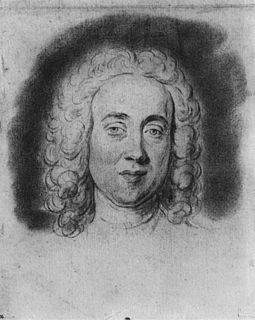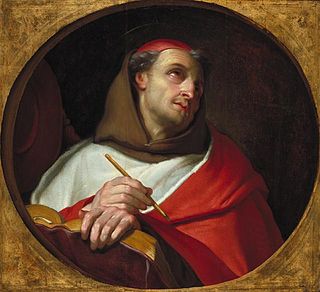
Claude Simpol, Claude Saint-Pol or Claude Saint-Paul (c. 1666 - before 1711 [1] ) was a French painter.

Claude Simpol, Claude Saint-Pol or Claude Saint-Paul (c. 1666 - before 1711 [1] ) was a French painter.
Born in Clamecy, he studied under Boullogne and frère Luc. He was admitted to the Académie de Saint-Luc on 23 March 1695 [2] and won several prizes (including the second prize in the 1687 prix de Rome for Noah's Flood) at the Académie royale, to which he was admitted on 30 April 1701. Specialising in grisailles, he was listed on 2 March 1709 as still not having provided his academy work, whose subject was Neptune's Dispute with Minerva, or the Naming of the City of Athens.
He was described by Pierre-Jean Mariette as an artist who had "little love for work" and who adopted "bad conduct, which continually forced him to struggle with need:. [3] Even so, he produced paintings for the menagerie at the Palace of Versailles in 1702 and 1703 and produced a May for Notre-Dame in Paris in 1704 (Jesus in the House of Martha and Mary, now in the Musée des beaux-arts d'Arras).
He also produced several drawings to be engraved and a teaching model for a polisher in Paris. [4] He also worked for the publisher Jean Mariette, who commissioned fashion plates, pastoral scenes and religious images from him. [5] These include a set of twelve scenes of rural subject matter, once thought to be by Jacques Stella, representing the months, [6] and a number of illustrations for Les Vies des SS. Pères des déserts d’Orient published in 1711. [7] He died in Paris.


The Académie Royale de Peinture et de Sculpture was founded in 1648 in Paris, France. It was the premier art institution of France during the latter part of the Ancien Régime until it was abolished in 1793 during the French Revolution. It included most of the important painters and sculptors, maintained almost total control of teaching and exhibitions, and afforded its members preference in royal commissions.

Simon Vouet was a French painter who studied and rose to prominence in Italy before being summoned by Louis XIII to serve as Premier peintre du Roi in France. He and his studio of artists created religious and mythological paintings, portraits, frescoes, tapestries, and massive decorative schemes for the king and for wealthy patrons, including Richelieu. During this time, "Vouet was indisputably the leading artist in Paris," and was immensely influential in introducing the Italian Baroque style of painting to France. He was also "without doubt one of the outstanding seventeenth-century draughtsmen, equal to Annibale Carracci and Lanfranco."

Théodore Chassériau was a Dominican-born French Romantic painter noted for his portraits, historical and religious paintings, allegorical murals, and Orientalist images inspired by his travels to Algeria. Early in his career he painted in a Neoclassical style close to that of his teacher Jean-Auguste-Dominique Ingres, but in his later works he was strongly influenced by the Romantic style of Eugène Delacroix. He was a prolific draftsman, and made a suite of prints to illustrate Shakespeare's Othello. The portrait he painted at the age of 15 of Prosper Marilhat, makes Théodore Chassériau the youngest painter exhibited at the Louvre museum.

Jean-Baptiste Claude Eugène Guillaume was a French sculptor.

Louise Catherine Breslau was a German-born Swiss painter, who learned drawing to pass the time while bedridden with chronic asthma. She studied art at the Académie Julian in Paris, and exhibited at the salon of the Société Nationale des Beaux-Arts, where she became a respected colleague of noted figures such as Edgar Degas and Anatole France.

Jean-Baptiste Santerre, was a French painter often associated with Jean-Honoré Fragonard but notable in his own right.

Gustave Clarence Rodolphe Boulanger was a French figure painter and Academic artist and teacher known for his Classical and Orientalist subjects.

Pierre-Jean Mariette was a collector of and dealer in old master prints, a renowned connoisseur, especially of prints and drawings, and a chronicler of the careers of French Italian and Flemish artists. He was born and died in Paris, and was a central figure in the artistic culture of the city for decades.

Louis-Pierre Deseine (1749–1822) was a French sculptor, who was born and died in Paris. He is known above all for his portrait busts and imaginary portraits.

Claude Lefèbvre was a French painter and engraver.

Jean-Joseph Taillasson was a French history painter and portraitist, draftsman, and art critic.
Albert Bitran was a French painter, engraver and sculptor.

Louis-René Vialy, also spelled Vially, Viali or Viallis, was a French painter.
Jean-Baptiste Lallemand (1716–1803) was a French artist born in Dijon. He was mainly a painter and draftsman of landscapes and genre works. He sometimes signed himself Lallemant or Allemanus. After a stay in Italy, he went to Paris and became a member of the Académie de Saint-Luc. He died in Paris.
Charles Michel-Ange Challe, born in Paris on February 13, 1718 and died January 8, 1778 is a painter, draftsman and French architect.
Jean-Charles Tardieu, also called "Tardieu-Cochin" was a successful French painter during the ages of Napoleon and of the Bourbon Restoration. His work was primarily historical, but also included landscapes, portraits and religious subjects.

Jacques-Nicolas Tardieu, called "Tardieu fils" or "Tardieu the younger", was a French engraver.

Portrait of Louis XIV in Coronation Robes was painted in 1701 by the French painter Hyacinthe Rigaud after being commissioned by the king who wanted to satisfy the desire of his grandson, Philip V, for a portrait of him. Louis XIV kept it hanging at Versailles. This portrait has become the "official portrait" of Louis XIV.

Claude François was a French painter and Recollect Franciscan friar. He is better known as Frère Luc, the name he adopted after becoming a monk

Clément Louis Marie Anne Belle was a French painter and tapestry designer.